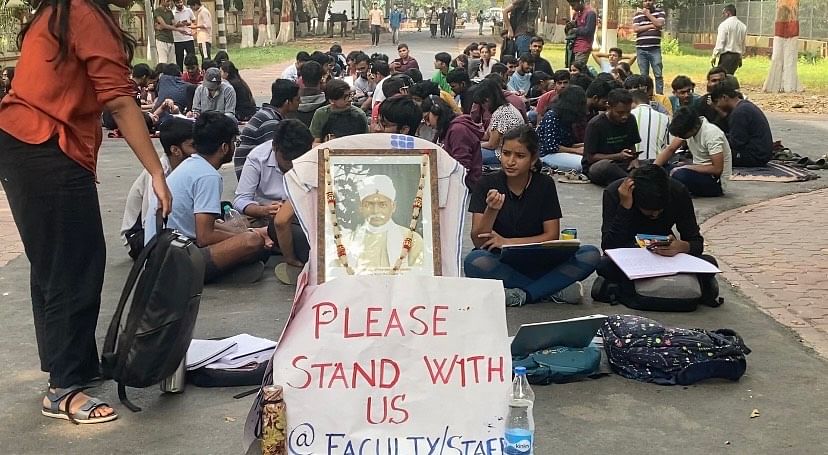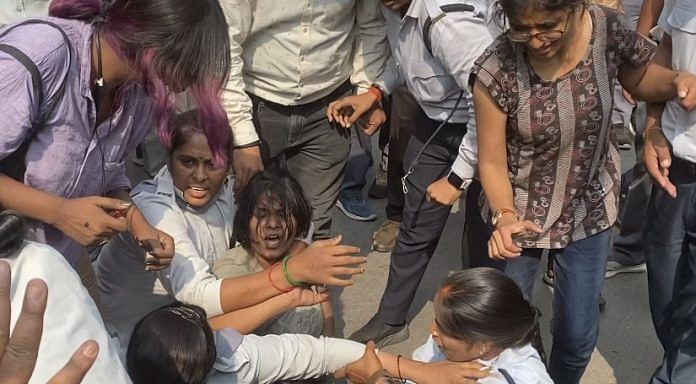The Banaras Hindu University campus, located in Prime Minister Narendra Modi’s constituency Varanasi, had an unusual new year’s eve this time. Three young men, all residents of Varanasi, and all with seeming links to the Bharatiya Janata Party, were arrested for allegedly gangraping a female student of IIT-BHU. Around 9:45 pm, the main gate for the IIT part of the campus was abruptly locked. About a hundred people, including students and local residents, found themselves stranded on either side of the gate. After thirty minutes of negotiations with the guards, who firmly cited “security concerns” and Chief Proctor’s orders, the gate was briefly opened. No ID cards were checked in the ensuing chaos.
It is precisely such arbitrary rules and theatrics that masquerade as safety measures for women, in most higher education institutions across India. In fact, recent events at IIT-BHU have once again highlighted how protectionism, instead of structural changes, further victimises women students. The 31 December arrests may have brought some sense of closure and justice. But these arrests came after two months of unrest, protests, and clashes between student groups. And yet, the dream of a truly safe and equitable campus remains deferred. The only concrete change? Further restrictions and surveillance. And, of course, political mileage for various stakeholders.
Some victories, many absurdities
The incident of sexual assault, which occurred on 2 November, united large numbers of IIT students. They insisted on the victim’s right to anonymity, demanded swift legal action against the accused, and kept petitioning the administration and police. However, the demands put forth through their Students’ Parliament revealed a dearth of imagination with regard to women’s safety. More CCTV cameras, more barricading, prohibition on entry of “outsiders” between 10pm and 5am—all the demands reeked of securitisation. Even the minutes from their parliament session, conducted months before the unfortunate incident, included some of the exact same demands. For the average IIT-BHU student, these seem to be the only solutions to sexual harassment/assault on campus.


Students from BHU departments contributed further to the obfuscation of the real issue. Many latched on to the IIT Students’ Parliament’s most controversial demand—a wall to be erected between IIT and the main campus, as the latter has a temple and shops frequently visited by Varanasi residents. A notice was issued by the IIT administration, promising to immediately look into the prospect of a wall, with the help of PWD. Multiple disruptions and demonstrations were staged by (mostly male) BHU students, with real-time and social media debates over whether founder Madan Mohan Malaviya would have wanted such a division of the campus.
Memes were circulated mocking IIT-BHU’s seemingly elitist self-image. Students from ABVP were soon heard chanting “Campus ka vibhajan nahin sahenge!” One student declared, in his bite to Navbharat Times, that the wall would have to be built over his dead body. The Instagram profile of IIT Students’ Parliament finally posted a statement, apologising for hurting the memory and legacy of Malaviya. Some groups such as AISA, NSUI, and Bhagat Singh Chhatra Morcha did raise more egalitarian demands of gender sensitisation, but were drowned out by ABVP’s FIR against them, carrying the usual allegation of having chanted “anti-national” slogans.
Meanwhile, the 10pm hostel curfew for BHU and IIT-BHU women students became stricter. Security personnel guarding the hostels, who would earlier allow “latecomers” on account of the 24×7 campus library, tightened their scrutiny. Fresh barricades came up around hostels, forcing women to walk longer distances after getting off from e-rickshaws or motorbikes. ID cards were checked at random. Non-student male friends were no longer allowed to accompany women home. The accessibility issues of disabled women students increased manifold. For men on campus, life continued as before, albeit with minor inconveniences.
Also read: In IIT vs BHU war, idea of a wall rises. Will it stop sexual attacks on women?
Feminist jurisprudence and women students’ movement
Neither was 2 November an isolated incident on the IIT-BHU/BHU campus, nor is the problem of sexual assault unique to any particular educational space. The large volume of news reports on the incident may be partially explained as voyeuristic curiosity for the graphic details, along with IIT’s apparent prestige and BHU’s status as a grand, old university. While the threat of violence and harassment is a tragic part of women’s everyday lives, only a few incidents are able to shock civil society on a large scale. The last time Indian citizens were jolted en masse by the gangrape of a female student was in 2012, in Delhi. Along with collective rethinking of safe public spaces, it was also a moment of arguably feminist jurisprudence and reform. It is crucial, at any stage, for us to recount this history.
While women at workplaces received some respite through the Supreme Court’s Vishakha Guidelines in 1997, it was only fifteen years later that the Sexual Harassment of Women at Workplace (Prevention, Prohibition and Redressal) Act 2013 was passed by the Lok Sabha. 2013 was also the year Justice Verma and his committee redirected conversations away from the idea of women’s “modesty” and towards faster trials for the accused. Rape was officially recognised as an expression of power against women. UGC itself put together a task force to examine the matter of sexual harassment on campuses. Subsequently, the Saksham Committee Report recommended guidelines specifically for higher education institutions in India. All institutions were required to have Internal Complaints Committees (ICCs) for grievance redressal for women, and JNU went so far as to institute a Gender Sensitisation Committee Against Sexual Harassment (GSCASH). This was a historic development, and meant as a model for other universities to emulate. GSCASH was considered as more democratic, owing to its entirely elected nature, as opposed to ICCs, which have members nominated by the institution.
All of this is to say that tangible solutions beyond securitisation were already provided 10-15 years ago by the best legal and academic minds of India. In fact, the UGC Saksham report directly addresses the problem of protectionism and states that “Campus safety policies should not result in securitization, such as over monitoring or policing or curtailing the freedom of movement, specially for women.” It also explains how reliable transportation, bathrooms, enhanced hostel facilities, and gender sensitisation are all vital for women’s safety and freedom from harassment. How unfair, then, for authorities and student bodies to jump directly to increased restrictions on women, as the only recourse!
BHU itself has had remarkable instances of women-led protests for autonomy and equality. It was in 2017 that, in response to a case of molestation, BHU women spoke out against their gender-discriminatory hostel curfews and had them rolled back from 8pm to 10pm. During these five years, 2012-2017, women students across higher education institutions agitated in courageous ways. DU, JNU, Jadavpur—everywhere, women pushed the envelope on safety debates. Pinjra Tod was at the forefront as an autonomous women’s organisation, arguing that hostel curfews were instrumental to policing women’s bodies and keeping the lines of caste, class, and sexuality intact, and it is through this securitisation that the everyday threat of violence is maintained. They also brought attention to the need for women’s participation in public spaces—an aspect BHU must look into, considering the male-dominated nature of the campus and Varanasi in general.
Also read: Face of protest at BHU, ‘hardcore’ Bhagat Singh disciple — meet Akanksha Azad, now in NIA crosshairs
Triple victimisation, and the way out
It is 2024 now. Pinjra Tod is essentially inactive. JNU’s GSCASH has been dismantled and replaced with an ICC by the university administration. There is no organised, nation-wide solidarity of women students in sight. The previous year began with students from EFLU, Hyderabad being charged with malicious FIRs for protesting against an incident of sexual assault, and ended with heartbreaking events at IIT-BHU. There is an obsession, now on campus, with the road where the assault occurred, as if restricting entry to the exact same place, that too only between 10pm and 5am, will prevent future incidents of assault.
Some more aspects deserve a brief mention: The administration meeting held, in response to protests by IIT students, was attended by the IIT-BHU director and BHU vice chancellor. The resultant press release of course focused on cameras and barricades, though it conceded that a wall was not feasible. Most ironically, a joint committee was formed to enhance the Women’s Grievance Redressal Cell, and the only woman on that committee is also the former Chief Proctor who, back in 2017, had protesting students booked under murder charges. The callous email sent out by IIT-BHU’s PR Cell must also be mentioned, for its blanket prohibition on media interactions by students without “prior authorisation.” The gag order justifies itself as an attempt to reflect the “integrity, values, and excellence” of the institution.
The main takeaway from this entire situation is that women are triply punished on campus. They suffer first, through the daily threat of violation; second, through the actual crime(s); and finally, collectively through the aftermath of reporting these crimes. And these three levels of punishment are intricately linked, because of which nothing less than a systemic overhaul will do. The last two months at IIT-BHU remind us that there is an urgent need for reorienting campus safety discourse away from protectionism, and towards structural equality and sensitivity. Campuses must be enriching spaces for young women, not yet another arena of curtailment.
The author is a PhD Scholar with the Department of English, Banaras Hindu University. Views are personal.
(Edited by Prashant)



